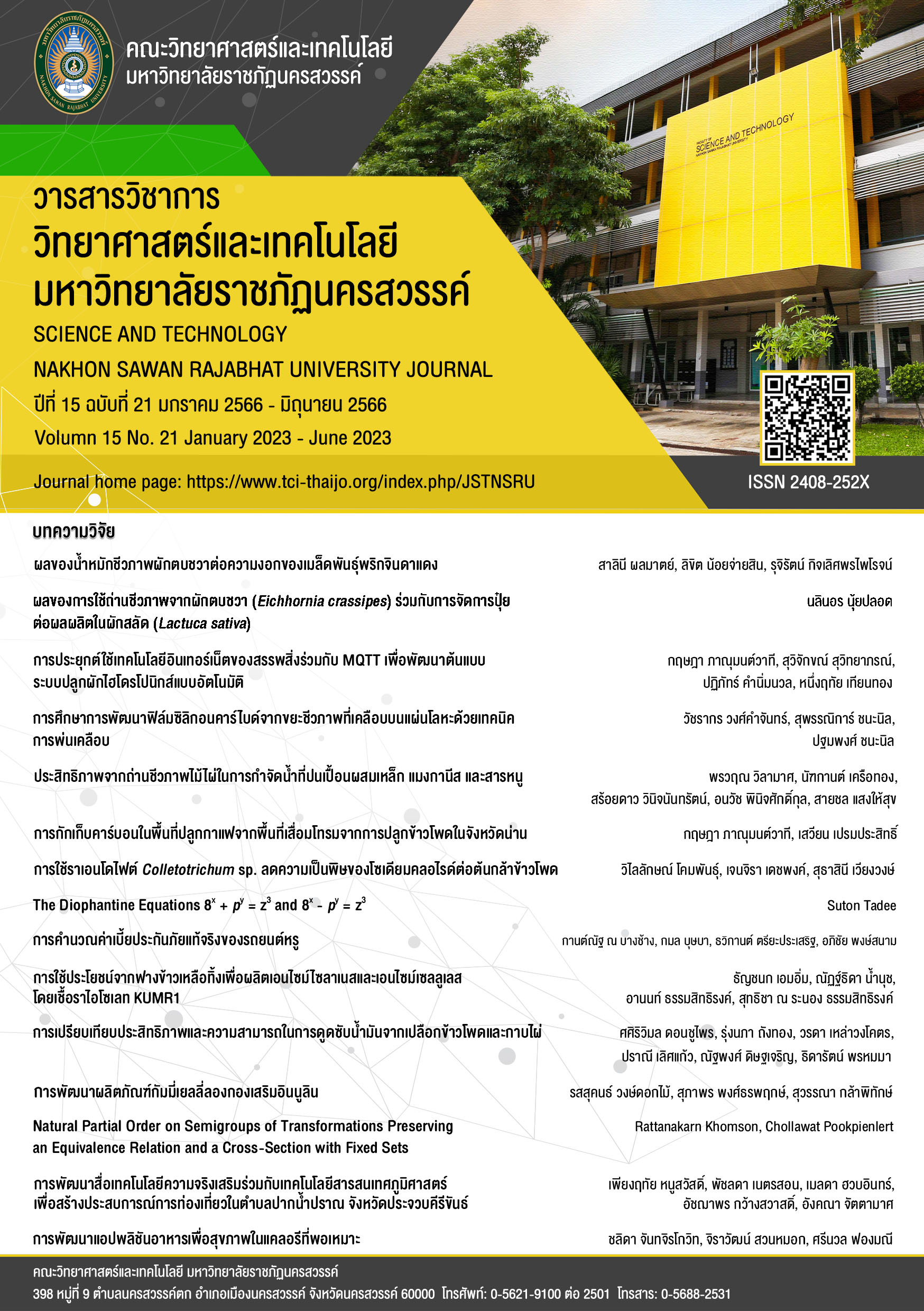การใช้ประโยชน์จากฟางข้าวเหลือทิ้งเพื่อผลิตเอนไซม์ไซลาเนสและเอนไซม์เซลลูเลสโดย เชื้อราไอโซเลท KUMR1
Main Article Content
Abstract
ฟางข้าวเป็นหนึ่งในวัสดุลิกโนเซลลูโลสที่มีมากในประเทศไทย ฟางข้าวเป็นวัสดุราคาถูกที่สามารถใช้เป็นสารตั้งต้นทางเลือกที่คุ้มค่าสำหรับการผลิตผลิตภัณฑ์มูลค่าสูง การศึกษานี้ได้ศึกษาการใช้ฟางข้าวเป็นสารตั้งต้นในการผลิตเอนไซม์ไซลาเนสและเอนไซม์เซลลูเลสโดยเชื้อราไอโซเลท KUMR1 ที่แยกได้จากดิน จากการศึกษาลักษณะสัณฐานวิทยาของเส้นใยเชื้อราภายใต้กล้องจุลทรรศน์พบโครงสร้างแคลมป์คอนเนกชัน (Clamp connection) แสดงว่าเชื้อราไอโซเลท KUMR1 เป็นเชื้อราในไฟลัมเบสิดิโอไมโคตา (Phylum Basidiomycota) เมื่อนำเชื้อราไอโซเลท KUMR1 มาเพาะเลี้ยงบนอาหารแข็งฟางข้าวและทดสอบความสามารถในการผลิตเอนไซม์โดยใช้วิธีการย้อมด้วยสารละลายไอโอดีน จากผลการทดลองที่พบโซนใสบนอาหารแข็งฟางข้าวจึงทำการศึกษาการผลิตเอนไซม์ไซลาเนสและเอนไซม์เซลลูเลสในอาหารฟางข้าวโดยการหมักแบบอาหารเหลวและการหมักแบบอาหารแข็งที่อุณหภูมิ 30 องศาเซลเซียส พบว่าได้กิจกรรมของเอนไซม์ไซลาเนสสูงสุดเท่ากับ 978.24 ยูนิตต่อมิลลิลิตร และกิจกรรมของเอนไซม์เซลลูเลสสูงสุดเท่ากับ 1.10 ยูนิตต่อมิลลิลิตร ในวันที่ 14 ของการหมักฟางข้าวแบบอาหารเหลว โดยมีกิจกรรมของเอนไซม์ไซลาเนสและเอนไซม์เซลลูเลสสูงกว่าการใช้ไซแลนและคาร์บอกซิลเมทิล-เซลลูโลสทางการค้าเป็นสารตั้งต้นเท่ากับ 5.19 เท่า และ 1.75 เท่า ตามลำดับ การศึกษานี้แสดงให้เห็นว่าฟางข้าวเป็นแหล่งคาร์บอนที่ดีสำหรับการผลิตเอนไซม์ไซลาเนสและเอนไซม์เซลลูเลสต้นทุนต่ำและเชื้อราไอโซเลท KUMR1 เป็นเชื้อราที่มีประสิทธิภาพในการผลิตเอนไซม์ไซลาเนสและเอนไซม์เซลลูเลส
Article Details

This work is licensed under a Creative Commons Attribution-NonCommercial-NoDerivatives 4.0 International License.
References
Abraham, A., Mathew, A. K., Sindhu, R., Pandey, A., & Binod, P. (2016). Potential of rice straw for bio-refining: an overview. Bioresource Technology, 215, 29-36. https://doi.org/10.1016/j.biortech.2016.04.011
Andlar, M., Rezić, T., Marđetko, N., Kracher, D., Ludwig, R., & Šantek, B. (2018). Lignocellulose degradation: an overview of fungi and fungal enzymes involved in lignocellulose degradation. Engineering in Life Sciences, 18(11), 768-778. https://doi.org/10.1002/elsc.201800039
Arora, S., Rani, R., & Ghosh, S. (2018). Bioreactors in solid state fermentation technology: Design, applications and engineering aspects. Journal of Biotechnology, 269, 16-34. https://doi.org/10.1016/j.jbiotec.2018.01.010
Arunrat, N., Sereenonchai, S., Chaowiwat, W., Wang, C., & Hatano, R. (2022). Carbon, nitrogen and water footprints of organic rice and conventional rice production over 4 years of cultivation: a case study in the lower north of Thailand. Agronomy, 12(2), 380-399. https://doi.org/10.3390/agronomy12020380
Bailey, M. J., Biely, P., & Poutanen, K. (1992). Interlaboratory testing of methods for assay of xylanase activity. Journal of Biotechnology, 23(3), 257-270. https://doi.org/10.1016/0168-1656(92)90074-J
Bakratsas, G., Polydera, A., Katapodis, P., & Stamatis, H. (2021). Recent trends in submerged cultivation of mushrooms and their application as a source of nutraceuticals and food additives. Future Foods, 4, 100086. https://doi.org/10.1016/j.fufo.2021.100086
Baramee, S., Siriatcharanon, A. K., Ketbot, P., Teeravivattanakit, T., Waeonukul, R., Pason, P., Tachaapaikoon, C., Ratanakhanokchai, K. & Phitsuwan, P. (2020). Biological pretreatment of rice straw with cellulase-free xylanolytic enzyme-producing Bacillus firmus K-1: Structural modification and biomass digestibility. Renewable Energy, 160, 555-563. https://doi.org/10.1016/j.renene.2020.06.061
Bharti, A. K., Kumar, A., Kumar, A., & Dutt, D. (2018). Exploitation of Parthenium hysterophorous biomass as low-cost substrate for cellulase and xylanase production under solid-state fermentation using Talaromyces stipitatus MTCC 12687. Journal of Radiation Research and Applied Sciences, 11(4), 271-280. https://doi.org/10.1016/j.jrras.2018.01.003
Dantas, C. P., Pinchemel, J. P. D., Jesus, G. M., Pimentel, M. B., Oliveria, O., Maria, C., Queiroz, A.F.S. & Lima, D. F. (2021). Bioprospection of ligninolytic enzymes from marine origin filamentous fungi. Anais da Academia Brasileira de Ciências, 93, 1-15. https://doi.org/10.1590/0001-3765202120210296
Dutt, D & Kumar, A. (2014). Optimization of cellulase production under solid-state fermentation by Aspergillus flavus (AT-2) and Aspergillus niger (AT-3) and its impact on stickies and ink particle size of sorted office paper. Cellulose Chemistry and Technology, 48, 285–298.
Elisashvili, V., Penninckx, M., Kachlishvili, E., Asatiani, M., & Kvesitadze, G. (2006). Use of Pleurotus dryinus for lignocellulolytic enzymes production in submerged fermentation of mandarin peels and tree leaves. Enzyme and Microbial Technology, 38(7), 998-1004. https://doi.org/10.1016/j.enzmictec.2005.08.033
Engling, G., Lee, J. J., Sie, H. J., Wu, Y. C., & Yet-Pole, I. (2013). Anhydrosugar characteristics in biomass smoke aerosol-case study of environmental influence on particle-size of rice straw burning aerosol. Journal of Aerosol Science, 56, 2-14. https://doi.org/10.1016/j.jaerosci.2012.10.001
Florencio, C., Couri, S., & Farinas, C.S. (2012) . Correlation between agar plate screening and solid-state fermentation for the prediction of cellulase production by Trichoderma strains. Enzyme Research. 2012, 1-7. https://doi.org/10.1155/2012/793708
Garbin, A. P., Garcia, N. F., Cavalheiro, G. F., Silvestre, M. A., Rodrigues, A., PAZ, M. F., Fonseca, G. G. & Leite, R. S. (2021). β-glucosidase from thermophilic fungus Thermoascus crustaceus: production and Industrial potential. Anais da Academia Brasileira de Ciências, 93, 1-11. https://doi.org/10.1590/0001-3765202120191349
Gautam, A., Kumar, A., Bharti, A. K., & Dutt, D. (2018). Rice straw fermentation by Schizophyllum commune ARC-11 to produce high level of xylanase for its application in pre-bleaching. Journal of Genetic Engineering and Biotechnology, 16(2), 693-701. https://doi.org/10.1016/j.jgeb.2018.02.006
Ghose, T. K. (1987). Measurement of cellulase activities. Pure and applied Chemistry, 59(2), 257-268. https://doi.org/10.1351/pac198759020257
Grujić, M., Dojnov, B., Potočnik, I., Duduk, B., & Vujčić, Z. (2015). Spent mushroom compost as substrate for the production of industrially important hydrolytic enzymes by fungi Trichoderma spp. and Aspergillus niger in solid state fermentation. International Biodeterioration & Biodegradation, 104, 290-298. https://doi.org/10.1016/j.ibiod.2015.04.029
Ibrahim, D., Weloosamy, H., & Lim, S. H. (2015). Effect of agitation speed on the morphology of Aspergillus niger HFD5A-1 hyphae and its pectinase production in submerged fermentation. World Journal of Biological Chemistry, 6(3), 265. https://doi.org/10.4331/wjbc.v6.i3.265
Kantharaj, P., Boobalan, B., Sooriamuthu, S., & Mani, R. (2017). Lignocellulose degrading enzymes from fungi and their industrial applications. International Journal of Current Research and Review, 9(21), 1-12. https://doi.org/10.7324/IJCRR.2017.9211
Ketsakhon, P., Thammasittirong, A. & Thammasittirong, S.N-R. (2022). Adding value to rice straw waste for high-level xylanase production using a new isolate of Bacillus altitudinis RS3025. Folia Microbiologica. https://doi.org/10.1007/s12223-022-00998-x
Kogo, T., Yoshida, Y., Koganei, K., Matsumoto, H., Watanabe, T., Ogihara, J., & Kasumi, T. (2017). Production of rice straw hydrolysis enzymes by the fungi Trichoderma reesei and Humicola insolens using rice straw as a carbon source. Bioresource Technology, 233, 67-73. https://doi.org/10.1016/j.biortech.2017.01.075
Metreveli, E., Kachlishvili, E., Singer, S. W., & Elisashvili, V. (2017). Alteration of white-rot basidiomycetes cellulase and xylanase activities in the submerged co-cultivation and optimization of enzyme production by Irpex lacteus and Schizophyllum commune. Bioresource technology, 241, 652-660. https://doi.org/10.1016/j.biortech.2017.05.148
Namnuch, N., Thammasittirong, A., & Thammasittirong, S. N. R. (2021). Lignocellulose hydrolytic enzymes production by Aspergillus flavus KUB2 using submerged fermentation of sugarcane bagasse waste. Mycology, 12(2), 119-127. https://doi.org/10.1080/21501203.2020.1806938
Razali, S. A., Rasit, N., & Ooi, C. K. (2021). Statistical analysis of xylanase production from solid state fermentation of rice husk associated fungus Aspergillus niger. Materials Today: Proceedings, 39, 1082-1087. https://doi.org/10.1016/j.matpr.2020.06.366
Youssef, M. I., Saber, W. I., El-Taher, E. M., & El daiem Sherief, A. (2016). Isolation and identification of the highly cellulolytic and P-solubilizing fungi. Journal of Environmental Sciences, 45(1), 75-84.


